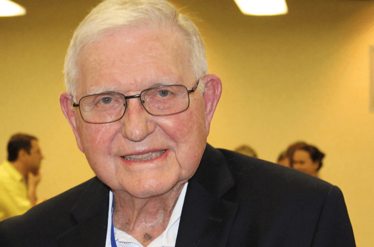Remembering Jack Kirkland
“One of the original pioneers of modern liquid chromatography,” Joseph (Jack) Kirkland (1925–2016) was not only an analytical innovator but also a mentor and educator. Here, the “father” of HPLC is remembered by friends and colleagues.
I first met Jack at the Gordon Conference on Analytical Chemistry in 1979. That was an era when women were not so welcome in science, but Jack was so supportive and encouraging to me. He even sent me a letter on DuPont stationery after the conference, telling me he enjoyed my short young investigator’s presentation and looked forward to hearing more. He’s been an inspiration throughout the years. He has always been at the leading edge as a scientist and as a human being. – Mary Wirth

Jack Kirkland (1925–2016) at HPLC 2014
Jack Kirkland was one of the original pioneers of modern liquid chromatography along with Joseph Huber and Csaba Horvath and he made many substantial contributions to the development of HPLC since its inception in the 1960s. In the mid-1960s, liquid chromatography used large-particle (> 50 microns) irregularly shaped totally porous silica, diatomaceous earth, and alumina particles and ion-exchange resins as column packings. These materials severely limited the efficiency and speed of LC separations. Jack began the transformation of liquid chromatography into the modern era of high performance liquid chromatography by developing processes to produce 30 micron spherical core-shell particles with 1-micron thick porous layers on liquid-impervious glass bead cores that were commercialized by the DuPont Company under the tradename Zipax. These superficially porous packing materials were major improvements to the packing materials previously used for liquid chromatography and, for the first time, liquid chromatography began to rival GC as the method of choice for separation applications.
Jack went on to develop many more innovative advances for HPLC but besides these major product developments, Jack has greatly contributed to the scientific community by helping to educate future generations of chromatographers through his books, lectures, scientific publications, and teaching courses. He continually demonstrated an ability to find and collaborate with many technical experts in a variety of fields to integrate technologies to accomplish his goal of finding new and better separations technology. He used his high volume of informative writing and lectures to inform a wide audience of chromatographers of his scientific results to stimulate interest and research into new and improved products and technologies for separations. Jack was extremely generous with his time, often seeking out students and young scientists to talk to and encourage. He was a mentor to many people, including myself, in the companies for which he has worked, helping them to solve problems and establish their scientific careers. His kind, gentle, and patient nature made him an excellent teacher. But his imposing presence and leadership skills provided encouragement for success among all the scientific relationships he formed during his career. His philosophy about research was often expressed when he would say to others: “There is no such thing as a bad experiment. Even if you fail to achieve what was expected, you have learned something by doing it.” – Joe DeStefano
I have known and worked with Jack at different times over the past 48 years. Jack was the last of the three individuals (including Csaba Horvath and Josef Huber) who can properly be considered “fathers” of HPLC. In my opinion, he was by far the primary contributor to the field during his 52 years of related R&D. Not only was he the major innovator in new column technology (see my remarks in The Analytical Scientist, November 2013), but he co-taught the ACS course on HPLC with me and others from 1971 to 1995 to over 5000 students, was a leader in organizing and directing the principal HPLC meeting from 1973 to the early 2000s, published 32 patents and 160 peer-reviewed articles, and co-wrote eight HPLC-related books. These cumulative efforts provided an enormous acceleration of the wide acceptance and use of HPLC. He received numerous awards and honors in recognition of his work. My personal impressions of Jack recall his drive, his innovation, his integrity, and his friendship; I often thought of him as a “force of nature.” – Lloyd Snyder
Those who have spent significant time with Jack will remember him fondly as the Gentlemen's Gentleman, in addition to his central role as a keystone contributor in separation science.
Jack and I first met by telephone in 1988, when he called me at the lab in Vancouver, BC, where I was studying molecular neurobiology. The call literally came out of the blue, and was in response to some questions I had posed for him in a letter sent some months earlier (yes, pre-email), concerning what I had termed non-ideal size exclusion chromatography. In addition to talking science, Jack had called to see if I had interest in visiting, or working, at the Dupont Central Research Department, upon completing my PhD at UBC. Before the call, I knew of Jack as a famous analytical chemist, and after the lengthy call (almost two hours), I knew him as an engaging person, with broad interests in chemistry, biochemistry, biophysics, travel and sports.
Somehow Jack had convinced me that I should consider experience in industrial research, before traveling the usual academic route that had been mapped out for me at one of several famous and desirable research institutions. When I visited the Experimental Station several months later, on my meet and greet tour of academic titans, my fate was sealed. Jack's clear excitement and dedication to the discipline and craft of science and technology development was like a gravitational field – the closer I got, and the more time we spent chatting, the more inescapable it became. After that initial visit to Delaware, I returned the next summer, starting a nearly 30-year collaboration that literally continued until his passing.
Even with periodic breaks of months or years, Jack had the ability to immediately infuse an interrupted conversation on "what could be done in the lab" as if no time had passed, and with a sense that there was no time to loose in getting it done! Above all, Jack greatly desired to see separation science play a greater role in biomedical research, and was not shy about throwing down the challenge for those with biochemistry knowledge to hurry up and get the two fields connected! I will sorely miss those chats, as I will his ready good humor, and above all his sense of doing what was right.
Over the years I got to share with Jack the occasional pleasant surprise of work very well done, as well as the frustrations of things that just did not quite measure up (what we called "to be completed later - maybe"). Over my career, I have rarely encountered a scientist, especially one of Jacks stature, for whom there was nothing bad someone could say about them. Although, as a professional community, we have many stars, or near stars, there are few who do not irritate someone along the way. Jack was one of those exceedingly rare people who managed this. I have yet to meet anyone who spent any time with Jack, who came away other than impressed by his interest in their scientific undertakings, and in them as a person. This is how I will remember Jack, as a great scientist, but also as a fine human being. He will be missed by many colleagues, technicians, students, and even the occasional manager, who benefited from his specific scientific contributions, general knowledge of the research and development enterprise, and ability to mentor younger people. – Barry Boyes
Through my whole professional life as a research scientist with Hewlett-Packard/Agilent Technologies, I have met with Jack as a customer – interested but critical about our products, as a host – showing me frankly and openly the processes involved in column technologies, as an Agilent colleague – keen on learning what was going on in the German Agilent site and last – as a respected and friendly competitor in the past years of my professional life. Jack was a gentleman scientist – always critical and persistent where his experience and separation science know-how did not substantiate what others were delivering as explanations, but at the same time remaining a sociable and polite godfather of liquid chromatography science. – Gerard Rozing
If you would like to contribute a comment or share a memory, please email: [email protected] or, alternatively, add a comment below.

Rich Whitworth completed his studies in medical biochemistry at the University of Leicester, UK, in 1998. To cut a long story short, he escaped to Tokyo to spend five years working for the largest English language publisher in Japan. "Carving out a career in the megalopolis that is Tokyo changed my outlook forever. When seeing life through such a kaleidoscopic lens, it's hard not to get truly caught up in the moment." On returning to the UK, after a few false starts with grey, corporate publishers, Rich was snapped up by Texere Publishing, where he spearheaded the editorial development of The Analytical Scientist. "I feel honored to be part of the close-knit team that forged The Analytical Scientist – we've created a very fresh and forward-thinking publication." Rich is now also Content Director of Texere Publishing, the company behind The Analytical Scientist.

















